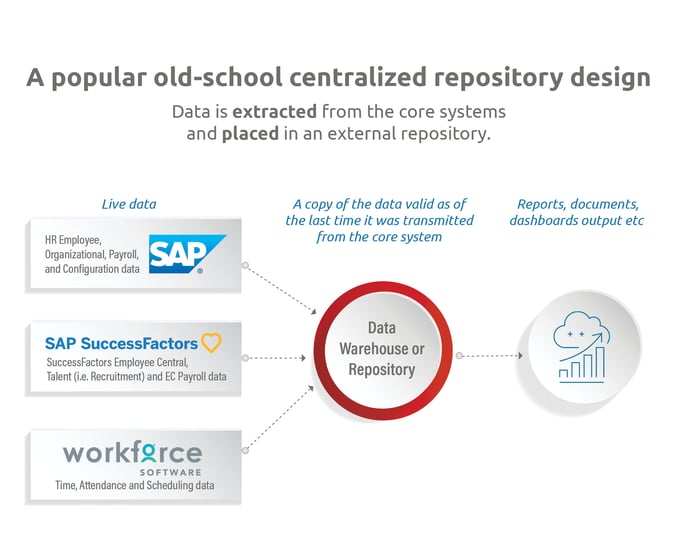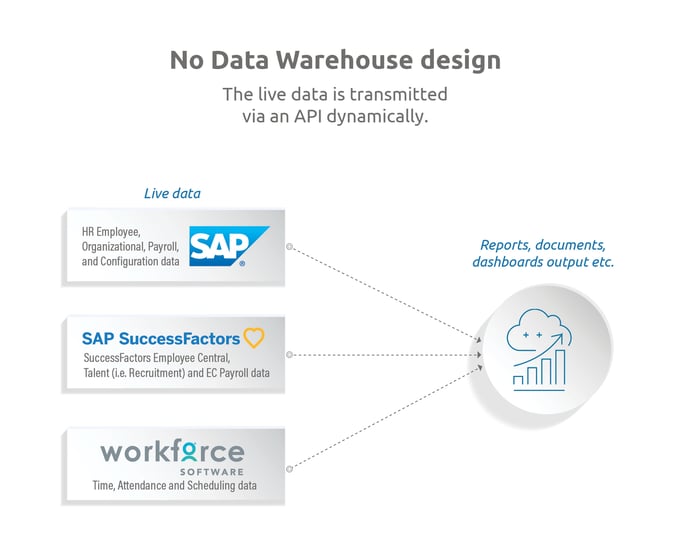How to make the most of your data – Part 1: Leave it where it is
By Danielle Larocca | 22 September 2021
SAP recently posted a news article called ‘Five Ways to Make the Most of Your Data’ that talks about how as economies have digitized, business leaders now recognize that data is at the heart of digital businesses. It then went on to detail the five ways to make the most of your data, which were:
-
Leave your data where it is
-
Make sure you can handle all data types
-
Harness data to drive automation
-
Democratize data
-
Protect your data
I really enjoyed the article, and I love all things data reporting and analytics, so I decided to chime in with my thoughts on each of the five items. Here goes...
I am passionate about data, especially accurate and real-time data. The only way to make informed decisions, whether it is about opening a new location, implementing a mass increase for a job or position eliminations, is to have the right information. Far too often, companies are making ‘guesstimates’ based on impressions or assumptions or rumors, when critical decisions for the business should only be based on facts and information.
Access to real-time data for decision-making
To make a good decision, you need data that is real time, unlike the old days when you had to take months to comb through files and data. Now executives, managers and employees expect to have all the information at their fingertips. We have been spoiled in a world of instant access and instant gratification, and we expect the same type of experience with all things HR and Payroll. Executives and managers need critical information at their fingertips about the enterprise to make informed decisions, and that data may come from several different sources; some from the sales system, some from finance, some from HR etc.
As described in the article, “too often companies try to centralize data via a large, top-down project where data from across the organization must be brought into a central repository. The problem with this approach: by the time you bring together data from across different parts of an organization into one place, it’s outdated.” I have seen this design used at many organizations over the years, and I recall that when ‘repositories and data warehouses’ were first introduced this was a popular method. It's easy to say you want all your data in a single place; however the truth is you actually want all of your data accessible via a single place in real time.
Let’s use the HR and Payroll example where your critical HR and Payroll data may exist in several places, which can include your SAP HCM ERP system, your SuccessFactors cloud solution, and third-party tools including the Time solution Workforce.

In the example shown above, key data exists in the three systems listed on the left hand side. In the old-school method, data was copied/extracted/transmitted from those core systems (also known as the ‘system of origin’) and then a copy of that data is placed into an external data warehouse or repository from which reports were created. In the early days of SAP Business Warehouse (BW), this data was transmitted from the core systems to the BW data warehouse on a weekly or monthly basis.
As you can imagine, there are several concerns with this design, including:
-
Once the data leaves the core system, it is no longer protected by the security protocols in place in that system
-
Once the data leaves that core system, it is no longer real-time data; it is rather a frozen look at the data as of the last time it was extracted
-
There is always risk when an additional step or system is added as formatting issues may incorrectly impact the data (leading zeros, dates, currencies, negative numbers etc.)
So, you need to leave your data where it is!
The first recommendation in the news article addresses the key point of leaving your data where it is, in the core system, and rather extracting it in real time directly for reporting and analysis as shown in the diagram below.

In the example above, the data from the core systems is dynamically transmitted directly to your report output. There is no copy of the data made and/or stored (replicated), rather it is received/transmitted dynamically directly to the output, ensuring real-time data is available for reporting and analysis to be used to make business decisions.
My favorite quote from the article is “People need to shift their mindset to connecting – rather than collecting – data”. At EPI-USE Labs, we make the connector that allows our clients to transmit their critical and hard-to-reach data to their external Analysis solutions, including Microsoft PowerBI, Tableau, SAP Datasphere and SAP Analytics Cloud (SAC).
Please feel free to reach out if you would like to see it in action.
My next blog will focus on the second item listed in the article, which is around making sure you can handle all data types.
Danielle Larocca
With over 20 years in SAP Human Capital Management, Danielle is a recognized leader in HR technology. She holds the distinguished roles of SAP Mentor and SuccessFactors Confidant, and serves as HCM Chairperson for ASUG (America's SAP User Group). Danielle is a sought-after speaker at international conferences, sharing insights on HR tech trends. She has authored four best-selling books on SAP and holds certifications in both SAP and SuccessFactors technologies.
Insights from SAP experts and industry leaders
Subscribe todayQuery Manager Analytics Connector Add-On: Connect to your analytics solution of choice